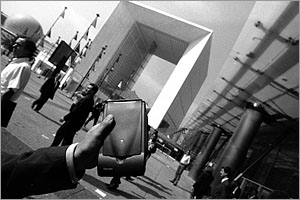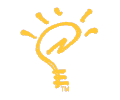


Steve Capps was codesigner of the Finder and much of the Mac's graphical user interface which in reality was the basis of all interface innovation for the last few decades. Steve continued to refine the Mac OS interface through the '80s, then he joined the Newton Group to help design the Newton OS. In addition to being one of the Newton's original parents, he was also chief architect of Newton OS 2.0, which revitalized the PDA and led to its much wider acceptance. In mid-1994, Apple recognized Steve's contributions by appointing him to its most coveted position: Apple Fellow. Capps holds a bachelor of science degree from the Rochester Institute of Technology
"The short version is that I worked with Xerox throughout the late 1970s and then came out here to work on Apple's Lisa. Then [Steve] Jobs kind of pulled me over to work on the Mac. I worked on that throughout the 1.0 release and, after a few of the minor releases, kind of bailed out in 1985 and lived in Paris for a year or so. I bummed around and wrote some musical software and then came back to Apple to do Newton." Recently, Capps has been a software architect at Microsoft and doing advanced work on next-generation user interfaces and Internet technologies.
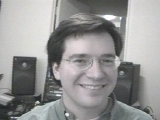
Walter R. Smith
Walter Smith (http://waltersmith.us) was one of the earliest members of the Newton team at Apple. He designed the NewtonScript language (nicknamed 'Wallyscript') and environment and Newton's object-based data storage system. In addition, he helped design the operating-system kernel, user-interface toolbox and development tools for the Newton. Smith holds a bachelor of science degree in applied mathematics from Carnegie Mellon University.
"There's no shortage of people named Walter
Smith. I'm the one that worked on Newton, a platform for little personal
computers (also known as Personal Digital Assistants) created at Apple
Computer. My main technical contributions to Newton were:
*The unified data model that ties the Newton software together.
*The compiler, interpreter, and runtime library for NewtonScript, the
language used to write Newton applications.
*The Newton object store, where all the persistent data in a Newton
resides.
I also helped with a bunch of other stuff, like the OS kernel abstractions, and the interaction between the view system, object model, and language (all of which are pretty cool, so you should read our papers).
Walter left Apple in April 1996 after almost eight years (all of which was spent in the Newton group) to try doing something new. Recently he has worked for Microsoft, first in the Applications and Internet Client Group with Steve Capps (who probably needs no introduction) and later in the Consumer Windows Division doing Windows Updates.
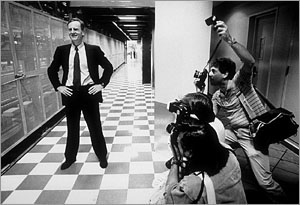
John Sculley
John Sculley is famous for his Newton and his days at Apple Computer. Before Amelio, before Spindler, John Sculley was steering the course at Apple. Hired by legendary founder Steve Jobs, who convinced him to leave Pepsi by asking Sculley if he wanted to "sell sugar water" for the rest of his life, Sculley became one of the leading figures in Apple mythology by heading the company from 1983 to 1993. Ironically, Sculley later ousted Jobs in a power struggle and then positioned himself as a technology visionary.
During his decade at Apple, the company's annual revenues rose from $600 million to $8 billion. True to his reputation as an unparalleled mass marketer, Sculley built Apple into a household brand.
After leaving Cupertino, he's split his time between new ventures to improve photographs on the Web and to bolster education through technology. He's written a best-selling book on his adventures in the marketing and high tech business, and he's served on an international human rights committee. But he's stayed in the tech game, serving now as the chairman of Live Picture.
As for Apple, Steve Jobs is back and Sculley is watching from the sidelines as the Macintosh starts another revolution called OS X.
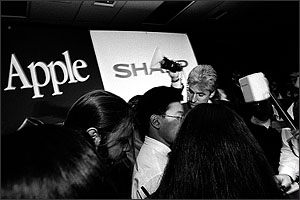
Michael Tchao
Although it is not clear what Michael Tchao is up to these days, he was largely responsible for the creation of the newton. Apple's advanced R & D had been working for years on slate computers that read handwriting and beamed data across the room ('Alien technology' Mulder would say). Yet these technologies were meant to be incorporated in high-end $5,000+ super cool computers of the future. He and Steve Capps came up with the idea of using some of these technologies in a small consumer device to be sold today.
The idea was completely rejected by the head of Advanced R&D at Apple. Yet, Michael believed this was such a great idea that he approached John Sculley directly while on the company plane over the pacific and made a successful pitch for the Newton project. Sculley had always hoped for such a device and was won over by the opportunity to father a revolutionary new paradigm in the field of personal computing.

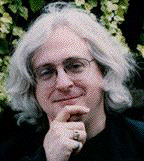
Stepan Pachikov and Larry Yaeger:
Handwriting Recognition Gurus
Stepan Pachikov -Father of Newton's "Cursive Recognizer"
When people picked up the original Apple Newton, for better or worse, much of their impression of the product was based on the handwriting recognition system (Calligrapher) that has been made so integral with the product's identity. And that put the handwriting system's developer, Moscow-based ParaGraph International, on the map. The company's president and CEO, Dr. Stepan Pachikov, took his programmers from starting a high-tech company in a communist country to licensing its technology to Apple Computer.
After developing handwriting recognition software to teach children to write, Pachikov realized the utility of this software and shopped his HWR technology to numerous companies in Silicon Valley (including a rejection from Steve Jobs at NeXT) before coming to Apple. "When we came to Apple; to see Larry Tesler, Steve Capps, and a few other people, we gave them a demo of our recognizer, using our digitizing tablet and a PC. First of all, as I remember, our system recognized nothing! Everything Larry Tesler tried to write gave the wrong answer. But they asked us how it works, and we started to explain it to them. We gave them a demo of all the key elements, and we explained to Larry that we try to recognize without context using the dictionary that we wrote ourselves. And they were impressed."
Larry Yaeger, Brandyn Webb & Michael Kaplan -Fathers of Newton's "Print Recognizer"
The new in OS 2.0 "print recognizer" in the Newton was developed by Brandyn Web, Michael Kaplan and Larry Yaeger in-house at Apple, in the Advanced Technology Group (ATG), later called Apple Research Laboratories (ARL). Brandyn Webb and Michael had came up with the concept, algorithms, and much of the code for what became the Newton 2.0 recognizer before the Newton project even happened. Larry came to work for Michael in Apple's ATG Neural-network research group after he left Alan Kay's lab in LA. Michael left the group before the work got into the Newton project, but Brandyn stayed on to finish up much of the code and algorithm development. Larry served as Technical Lead for the project which produced what many are calling the first usable character recognizer. A complete paper, "Combining Neural Networks and Context-Driven Search for On-Line, Printed Handwriting Recognition", by Larry Yaeger, Brandyn Webb, and Richard Lyon, was published in AAAI's AI Magazine, containing a discussion of the complete recognition system.
Larry: "Thanks (to those who have said nice
things about the Print Recognizer). It's been nice to see the positive
response to the print recognizer in 2.0 and 2.1. Despite our tests
looking good and our own hands-on use seeming to work well, we still
feared what would happen when it went out into the big, wide world. We
kept the entire Doonesbury strip dealing with the original Newton on
our wall as a reminder of what we were facing if we failed. And,
incidentally, there's definitely more to the print recognizer than just
the neural network classifier. There's character segmentation code,
word segmentation code, multiple geometric context models, language
context models, and an efficient search engine, in addition to the
character classifier, at just the largest level of detail, plus
zillions of finer details. So no need for the "oops" and
recharacterization."
![]()
Sandy Bennett and "Newton Inc." - the short-lived Apple subsidiary
Through the trials and tribulations of Apple Computer, the Newton Systems Group had been on the chopping block more times then we wish to remember. In late spring of 1997 the media fed over one more rumor that the current Apple CEO, Gilbert Amelio, was finally going to sell off or kill the Newton. Amelio surprised them in a May 22, 1997 Press Release announcing the Newton Systems Group would be spun off of Apple into a completely independent subsidiary, "Newton, Inc."
Amelio: "We believe that the time is right to establish the group as a focused entity. This decision allows the new subsidiary to pursue its business and create the marketing and operating strategies it needs to succeed."
The spin-off of NSG excited many people that
believed the Newton platform, and a company dedicated to it, could
flourish if allowed. The new company was to be led by a CEO to be named
later and the newly appointed Chief Operating Officer, Sandy Benett.
Benett was previously vice president of the Newton Systems Group and he
had been responsible for managing the group for several years. The
independent "Newton Inc." lasted from July 2 until September 19, 1997
when Steve Jobs brought Newton back into Apple. (In July of 1997,
Gilbert Amelio and the board of Directors of Apple Computer were tossed
out and Steve Jobs took over as temporary CEO). Jobs was never a fan of
the Newton, but he may have transiently believed in Steve Wozniak's
(also back at Apple) predictions about a bright future of the Newton
eMate computers (see letter from Jobs).
Sandy Benett resigned as did many of the higher up Newton Inc people and
Jobs later laid off numerous others. The freedom found in Newton Inc,
that had both excited and perhaps frightened newton users everywhere,
ended. What happened to Newton, well, re-absorbing Newton Inc was a
mistake. Five months later (February 27, 1998, Press
Release) Steve Jobs killed the Newton OS, the MessagePad, and
eMate300. This surprised many, especially the state of Texas that was
planning on buying several million eMates to replace students textbooks
and the entire country of Australia that actually planned to replace
the governments aging PC computers with all eMates. We call it
"snatching defeat out of the jaws of victory." Why, because a laser
focus on Macintosh was needed to revive/save Apple Computer. Yet just
as Windows eventually replicated the Mac experience for DOS users, some
PDA (perhaps PalmOS or PocketPC) in the future will replicate Newton
and the idea will succeed.

Newton Systems Group Engineers
For the numerous names not yet written here but who have greatly
contibuted
their passion to the design of Newtons, thank you.
(To get a peek at some of the Apple people that
worked on your Newton,
write "about Newton" in your MessagePad's Assistant and
hit the "Do" button)
NewtEvangelists and Programmers

Steve Holden -Premiere NewtEvangelist & San Diego publisher of the ubiquitous Newton Newsletter "NewtNews" (http://newtnews.webjump.com) from June 1994 to July 1999. Email Steve at sholden@pobox.com and read his current work related to handhelds at http://www.pencomputing.com.
Hardy Macia -Developer of "Aloha, MORGAN, Silk, PowerRecorder, MPG, Pocket Money" and many more Newton apps at his Vermont-based company, Catamount Software (http://www.catamount.com).
Ben Gottlieb -Developer of over 60 applications for the Newton platform ("Heap Saver, HWRWorks, DateMan, BackDrop Plus" etc) of Stand Alone, Inc.with Erik Wiessmann on the north side of Chicago (http://www.standalone.com/).
Dan Rowley -Developer, Innovative Computer Solutions of Phoenix, Arizona (http://www.newts.com) with Tom Collins. Author of of "NewtCase, GestureLaunch, BarKeep, X-port" and more.
David Fedor -Creator of the freeware Newton binder "Paperback" (http://www.pobox.com/~fedor) that lets everyone make Newton Paperback Books.
Jason Harper -A Developer's developer and author of "ViewFrame" (http://www.cdpubs.com/vframe.new.html); an ingenious and valued application that allows Newton programmers get a look at code.
Serg Koren -NewtEvangelist and Developer of "VisualNewt" and "Newt'sPaper" of Horsham, PA (http://www.netaxs.com/~archimag/Newton.html).
Don Vollum -Developer of "QuickFigure"/NewtonWorks Spreadsheet at PelicanWare (http://www.pelicanware.com/)
Steve Weyer -Developer of "Newt's Cape", "NewtDevEnv", and "Sloup" of Ashland, OR (http://communicrossings.com/newton-messagepad)
Lee Moon -Multimedia genius known for the Newton "Palmedia" QT movies, especially "The Simpsons Movie" (http://members.aol.com/LeeMoon).
George Henne -Creator of an environment that allows the use of BASIC language for the Newton platform, "NSBASIC" (http://www.nsbasic.com).
Clinton Logan -From Auckland New Zealand,
and now residing in New York City, he has designed and created numerous
Newton applications such as: Photoshow, QuickNames, proCALC, Lunar
Lander, Merlin, Wordsleuth, etc
(
http://www.landware.com/people/clinton.html ).
David MacNeill -He's the original newton columnist. His "Newton Notes" column has been in publication since Sept. 1993. He even beta tested the OMP! Go Pen Computing Magazine (http://www.pencomputing.com).
Ashley Armstrong, Mark Underwood, Rob Bruce -NewtEvangelists and developers from way back. Remember eWorld? Check out AMUG, NANUG and more (http://www.amug.org).
Jeffrey Schlimmer -WSU Prof. whose class formed "PowerPen". Famous for one program called "powerBack" that users could create their own custom version on PowerPen's Web site.
Flash Sheridan -The NewtEvangelist/Newton Systems Group Test Programmer who is well known for his software and for making the Stanford Newton User Group (SNUG) THE place to be for Newton folk (http://pobox.com/~snug/).
Adam Tow -The NewtEvangelist/Programmer who is well known for style and software at Foundation Systems and SNUG as well as leading the rebellion VS. Apple when the NewtonOS was discontinued (http://www.tow.com).
Glen Raphael -The Stanford Newton User Group (SNUG) Founder and Dictator for Life (http://pobox.com/~snug/).
Maurice Sharp -rumored to be the true 'Dr Llama' a.k.a. 'Commander Clueless' of Newton Developer Support.
Matt Vaughn -the man who made the Newton a portable web server with NPDS Newton Personal Data Sharing, Wow (http://homepage.mac.com/LightyearDesign/).
Paul Guyot - A NewtEvangelist/Programmer who creates Newton ROM dumps, system patches, ATA flash drivers and maintains NPDS Newton Personal Data Sharing. (http://www.kallisys.com/newton/).
Erica Liebman Sadun -The Georgia Tech grad
student that created "Figgles Utilities" in 1993.
AllPen Software -The folks who created NetHopper for
Newton-- the original and eventually bundled web browser. Todd
Courtois wrote the original version, and he worked in the Newton group
at Apple (with Maurice Sharp et al) before joining AllPen. AllPen
also had Patty Wells working for them, who was Jeff Schlimmer's grad
student. Some of the original AllPen folks have a startup,
RocketMobile www.rocketmobile.com.
And Todd is still doing mobile device programming (Symbian, BREW, J2ME) www.rawthought.com
Steve Elms -Founder/owner of the "NewtonSource" chain of Newton retail stores and all the folks that worked there and supported users so well.
Scott Silverman -Author of the top selling title on the Newton, MoreInfo. The coolest integrated contact manager ever (http://www.silverware.com/)
Al Willis - head of the Boston Computer Society Newton Group, formed in 1992, and still active today as BOSPDAUG (Boston PDA Users Group) http://www.bospdaug.org/
